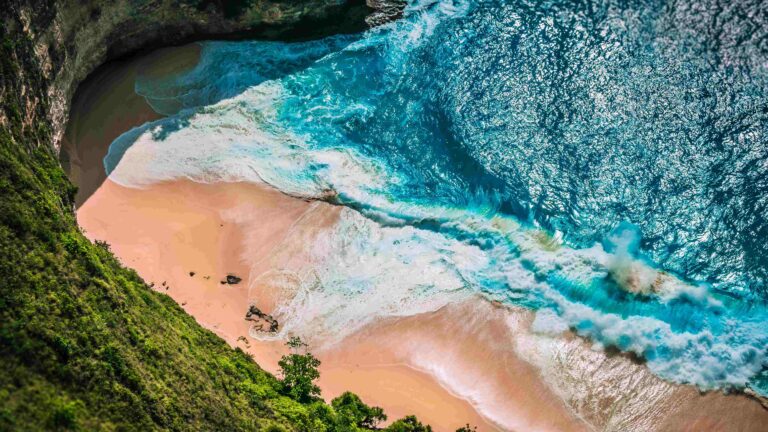Australians come to Bali to escape the Winter, and Europeans come to maximize their summer holidays, and that’s because the dry season in Bali is from March to September.
The wet season runs for the other six months of the year, but before you let that put a damper on your holiday plans, you need to read this guide to the rainy season because it’s better than it sounds.
Some people even prefer to come here for Bali’s wet season! Here’s why.
What Is The Bali Rainy Season?
This part of Indonesia has two distinct seasons: rainy and dry seasons. The wet season runs from October to February, and the dry season runs from March to September.
Of course, the weather is only as reliable in Bali as anywhere else on Earth and you may find that the rains come a month early or a month late.
Is This The Same As Monsoon Season?
Yes and no. Technically, the rains are considered monsoons throughout the season, but the heaviest rains are in December and January.
Most people consider Bali’s monsoon season to be those two months only. The rain is more like a brief tropical storm than an endless downpour for the rest of the wet season.
What’s It Like During Bali’s Rainy Season?
This is Indonesia, not the UK and you shouldn’t expect the Bali weather to mirror Northern Europe’s cold, damp discomfort, either.
Mainly, the Bali rainy season consists of brief tropical storms. That is, you run for shelter when the rain starts and then an hour later, you’re back on the beach at FINNS with a drink in your hand.
Now, during the rainiest of months? It can get a bit heavier and rain throughout the day. That’s the perfect time to hit the gym or spend a day enjoying the company of others while avoiding the rain at a good bar.
It can sometimes flood during the Bali monsoon season, making getting in and out of some areas a bit awkward.
The waters tend to clear quickly once the rain stops though, you won’t be stranded somewhere for a week.

Perils Of The Rainy Season
Before we turn to why the wet season is a great time to visit Bali, let’s take a quick look at some of the issues that the inclement Bali weather can cause:
Thunder Storms And Lightning
It’s OK to swim in the rain. It’s often a great time to swim because everyone else is hiding from the rain and you get the water to yourself.
But… it’s a bad idea to go swimming if you can hear thunder in the distance or worse, you can see lightning.
The Bali rainy season’s electrical storms can be pretty, but getting struck by lightning won’t be as much fun.
You Need To Take Care When Driving
If you’re getting around Bali on a scooter (and most people who visit Bali do), then you need to exercise caution in the rain.
The rain can get painful when it’s beating down, and you’re speeding along on your scooter. It’s like having tiny rocks beat on your body.
You can easily evade this problem by picking up a raincoat (not an actual coat, one of the famous “Bali Macs” which cover your whole body and cost next to nothing) and wearing it in the rain.
If the rain gets really heavy, it’s best just to pull up somewhere and let the worst of it pass before you continue to drive.
Mosquitoes Like Rainy Season In Bali
Mosquitoes breed in pools of stagnant water. And the easiest way for those pools to form is for it to rain.
Bali has no malaria-carrying mosquitoes for you to worry about, but Dengue fever is a concern.
Dengue mosquitoes come out early in the mornings and you’re best off covering up for this period (a long-sleeved shirt and a pair of trousers) or using a mosquito repellent (DEET being the most popular choice).
However, while dengue can threaten people’s health, the first time around it’s generally like a reasonably severe flu. So, don’t panic about this too much.
You should head to a doctor if you have a fever, headaches, muscle fatigue or joint pain, though. That’s because dehydration is the main threat to dengue, and it can help you stay hydrated.
Trekking Becomes A Bit More Challenging
It will come as no surprise, but when it rains in the great outdoors, you tend to get a bit of mud.
That can make a hike up Mount Batur a pain because everything is slightly slippier.
Rice terraces and paddies love the water because it helps the rice crop, but you may want to avoid wading through flooded fields of rice, too.
One tip for navigating this part of Bali’s rainy season is to take your shoes off when it’s muddy. Thongs have almost no grip in the wet.
(P.S. If you don’t know where to go trekking in Bali – check out our best hiking trails in Bali).
A Bit More Rubbish On The Beaches
One downside of the wettest months is that they can see more rubbish washing up on the beaches than in the dry months.
However, there are beach cleanup volunteers all over Bali who try to keep things manageable and mostly, they do a great job. We do a cleanup each week at FINNS, too.
Why Bali’s Wet Season Is Awesome
OK, that’s enough warnings! Let’s look at why you should skip the dry season and visit Bali in the low season instead.

Visiting Bali In The Low Season Is Cheaper
Bali hotels‘ rooms are cheaper in the rainy season than in the peak season.
They are cheaper. We’ve seen discounts of as much as 50% over the dry season! This is partly because there are fewer school holidays at this time of year.
This won’t usually apply during the Christmas/New Year period. Those times are super popular here in Bali.
The same is true of flights. When the airlines aren’t enjoying a high-season boom, they’re still hoping to sell all their seats, which means discounts.
Don’t book last-minute flights or you’ll pay as much as you would in high season.
Beat The Crowds
While Bali is a year-round destination, not everyone has got the memo and there are far fewer crowds at most tourist attractions during the rainy season in Bali.
See Some Waterfalls At Their Best
One perk of bad Bali weather is that the island’s numerous waterfalls look fantastic when it’s raining. The more it rains, the better they look.
Jembong Waterfall is gorgeous when it starts to rain and is a great place for spiritual healing.
And if you want a souvenir of the rainy season in Bali for your Instagram? Head to Tukad Cepung waterfall in the rain. It will blow your mind!
And you can find plenty more in our roundup of the best waterfalls here.

Go White Water Rafting
Yes! If you want your adventures to have maximum thrill, it must be raining to enjoy white water rafting. The harsher the Bali weather is? The better this activity becomes.
Try that in high season and you’ll find a river full of rocks that you have to push your way down. When it rains? You can go with the high-powered flow.
Take Up Yoga
You don’t need Bali’s dry season to enjoy a yoga retreat! If it’s pouring down outside, you’re less likely to want to be on the beach and more likely to be open to staying present in classes.
Become A Silversmith
This is a great way to spend a day or two in the rainy season. There are classes in Bali (book through our travel agency for a great time) that let you learn to make jewellery in traditional artisan styles.
Get Into Balinese Cooking
We know you’re on holiday. You didn’t come to cook for yourself. But taking a cooking class isn’t the same thing.
Not only is hanging out with other people learning about local ingredients and cooking techniques fun, but the end product is tasty and you don’t have to do the washing up!
Another advantage of taking a cooking class is that it can make ordering what you want in a local restaurant easier!
Of course, these classes run all year round, but they’re cheaper than they are in dry weather too.
Our travel agency can hook you up with a great cooking class too.

Chill Out In Cafes
If it’s one of those rare weeks when the Bali weather is only rain, don’t despair! The rainy season is the perfect time to enjoy Bali’s cafe culture.
Cerita Manisan, for example, is a great place to boost your Instagram cred back home. Bali’s cafes will be okay with you taking a book and digging in for the long haul, too. And there are hundreds of cafes to choose from.
Get Some Language Lessons
Nobody wants to spend the dry season cooped up in an Indonesian class, but if you’re a regular visitor to Bali, learning the language can open up new opportunities.
And there are plenty of schools to choose from, so you’re sure to find something that suits your budget and learning style.
The good news is that Bahasa, the Indonesian language, is one of the easiest languages to learn in the world. Even a concise program of study will make a dramatic difference to your language skills.
Check Out The Cinema
You can find some excellent cinemas in Bali. Not only do they show English-language movies (with subtitles), but they offer super comfortable theatres for much less money than at home.
If you can find a premium screen, you’ll get a luxury reclining chair and a blanket and they’ll bring out your popcorn and snacks to you!
Enjoy Some Water Sports
Unless there’s lightning coming down, nothing can keep you out of the water in a bit of rain. Of course, it’s best to watch the sea conditions too.
Surf spots can be awesome in the rainy season, but you don’t want to ride a tsunami-like wave, either.
Getting out in the water is one of our favourite rainy day activities because you get fewer people in the water, which means we can have more fun!
Go Out And Take Photos
Rice terraces, waterfalls, and pretty much everything else look better after a bit of rain.
That’s because everything gets parched during the dry season in Bali, like the grass on a lawn in a hot summer. But when the rain comes, it all springs back to life.
You could also practice your drone photography at this time of year (drone laws in Bali are quite relaxed) before things get busier later in the year.
Enjoy Indoor Activities In Bali
Keep Partying!
At FINNS, we don’t go home because there’s a bit of rain! Some of the best parties we’ve ever had have been during the rainy season. People are always willing to let themselves have fun when the music starts!
Dry or rainy season, you can rely on access to the best parties in town every day of the week!
Share this entry












